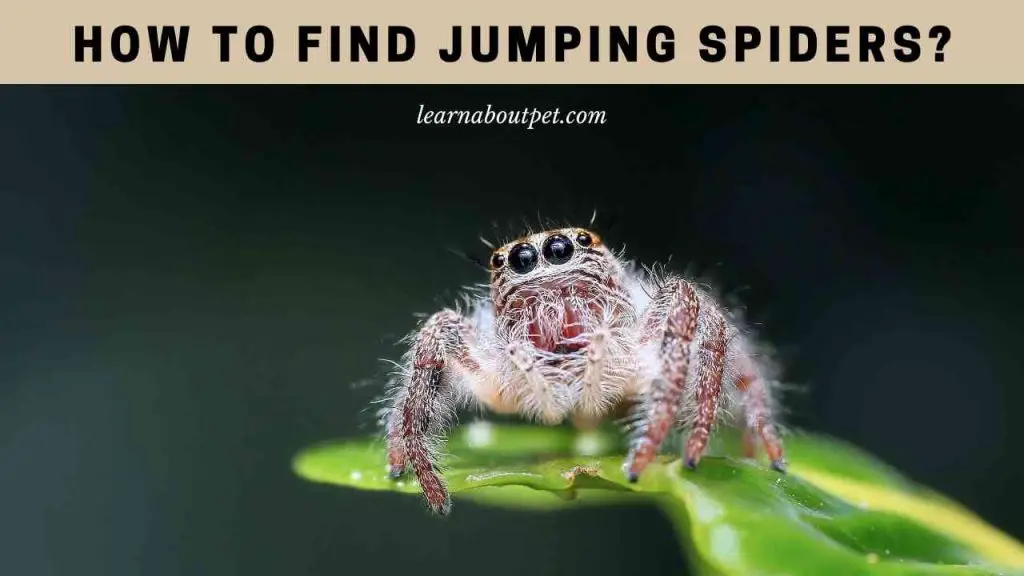Finding, catching and keeping jumping spiders can be great fun. In this article, you will find information on where to go looking for jumping spiders, how to catch them and how to take care of them thereafter. You will also find info on buying jumping spiders, if that is what you prefer.
In a nutshell, this is how to find jumping spiders: by beating vegetation, catching them using a beating sheet underneath the vegetation, then transferring them into vials. There is also the option of scooping them up directly from tree barks, rocks or walls using vials and gloved hands.
There are various online vendors from whom you can buy jumping spiders, if that is the route you prefer to take.

Most brick and mortar pet shops may not stock jumping spiders. But you can still check around to see if those in your area have these spiders.
After finding the jumping spiders, you need to take good care of them. Provide each spider with a big enough container to live in, live food and water through the misting method.
What Is A Jumping Spider?
Jumping spiders are arachnids of the salticidae family, which mostly hunt by stalking prey, then jumping (pouncing on) and killing it using their fangs and venom.
They therefore don’t (for the most part) trap their prey using intricate webs, like most other spiders. Instead, they pounce on prey and kill it. This is why they are referred to as ‘jumping spiders’.
How Many Types Of Jumping Spiders Are There?
Before setting out to learn how to find jumping spiders, it is important for us to first know how many types of jumping spiders there are.
There are very many types of jumping spiders. In terms of species, there are presently more than 6,000 different jumping spider species.
Examples of jumping spiders that people commonly keep as pets are the zebra jumping spider, heavy jumper and tan jumping spider. Others are the regal, the bold and the shiny jumping spiders respectively.
How To Identify A Jumping Spider?
Another thing we need to know, before setting out to learn how to find jumping spiders, is how to identify them.
It wouldn’t make sense to set out in search of jumping spiders if you don’t know how to identify them.
Thankfully, jumping spider identification is not too challenging.
In terms of color, most jumping spiders will be black or gray. But we also have those that are brown or tan in color.
Besides their main body color, they may also tend to have pale color markings.
Close examination reveals that jumping spiders’ legs – unlike those of most other spiders – don’t have spine covering.
Further, close examination reveals that jumping spiders’ faces are more or less rectangular.
In jumping spiders, we find that the four front legs are somewhat larger than the jumping spiders’ hind legs. This is probably to facilitate the jumping.
All jumping spiders will have eight eyes. The four front eyes are more conspicuous than the rest.
In terms of body size, a length of between 1 millimeter to 25 millimeters is typical in jumping spiders.
And of course, unlike other spiders that hunt by building webs, the jumping spiders use a pouncing and killing strategy while hunting. They prefer to hunt from above.
Therefore you will typically find them on highly placed surfaces, rather than on ground level.
That, right there, is a brief but handy jumping spider identification guide.
And having thus understood how to identify a jumping spider, we can start delving into the question of how to find jumping spiders. But first, let us find out where these spiders typically live.
Where Do Jumping Spiders Live?
The first key question we need to tackle, while trying to understand how to find jumping spiders, is this one: on where they live.
You are likely to be more successful in finding jumping spiders if, to start with, you know where they live.
This question, on where to find jumping spiders is a tricky one: as these spiders are found in all manner of places.
Therefore there is no one single answer you can give to the question on where to find a jumping spiders.
In the wild, some jumping spiders live in forests. We also have those that live in deserts. And we have those that live in rocks, eating the insects that also live there. We have others that live in open grasslands.
For the jumping spiders that live in trees, you may find some on the leaves, others on the branches and yet others on the tree barks.
All in all, the places with the highest concentrations of jumping spiders are the tropical forests.
But mountain regions, as well as scrublands and deserts (as well as temperate forests) may also host some jumping spiders.
Out of the wild, we have those that live in people’s gardens, on farmyards and even inside people’s houses.
Therefore the best way to answer the question on where do jumping spiders live is by asserting that they live “everywhere”.
Subsequently, “anywhere” is a potential hunting ground for you, if you are trying to learn how to find jumping spiders.
Where Are Jumping Spiders Native To?
To put it differently, where do jumping spiders come from?
There are many different species of jumping spiders, and they are native to different places.
The only place that doesn’t have jumping spiders that are native to it is the Antarctica.
All other continents – North America, South America, Europe, Africa, Australia and Asia – have jumping spiders that are native to them.
Of course, some continents seem to have more jumping spider species that are native to them than others. Conversely, some continents seem to have fewer jumping species spiders that are native to them.
For instance, there are roughly only around 300 species of jumping spiders that are native to the US and Canada.
Where Do Jumping Spiders Live In The US?
As pointed out earlier, in trying to learn how to find jumping spiders, it is essential to know where exactly they live. This is what leads us to this question, on where jumping spiders live in the US.
The answer is that jumping spiders live in pretty much all parts of the US.
You may find jumping spiders in US’ forests, deserts and open ranch grasslands.
You may also find jumping spiders in the US living in people’s home yards, gardens and even right inside people’s houses.
Where Can I Pick Up Jumping Spiders?
In other words, where can jumping spiders be found?
There are several places where you can pick up jumping spiders.
You can start with bushes. Jumping spiders like staying in bushes, hunting the various insects that hang in there. You will usually find the spiders in the upper parts of the bush trees.
In any given bush tree, you may find the jumping spiders on the leaves. Or you may find them on the branches.
Besides the small bushes, you may also find jumping spiders on bigger trees. In the bigger trees, the jumping spiders will normally be on the bark.
Dry leaves do sometimes host jumping spiders. The dry leaves attract many types of insects, which jumping spiders prey on.
Occasionally, you may find jumping spiders underneath rocks.
Your own garden (if you have one) is also a place where you can potentially pick up jumping spiders. You may find them on the garden trees. Or you may find them on the garden fence posts.
Abandoned houses, if you are daring enough to venture into them, may also host jumping spiders. Here, the jumping spiders will normally be on the walls.
Even your own house may be host to some jumping spiders. You can pry on the walls – to see if you are lucky enough to find some.
What becomes clear is the fact that any place really is potentially somewhere you can pick up jumping spiders. That is with the exception of water bodies.
The most important thing is to know what you are looking for, and be in a position to spot it at just the right time.
That, in essence, is the answer to the where are jumping spiders found question.
How To Find Jumping Spiders?
The most important thing, when it comes to figuring out how to find jumping spiders, is to know how to spot them.
You may spot jumping spiders by their body forms. Or you may spot jumping spiders by their movement.
The key thing is to know the sorts of areas, within any given habitat, where you are most likely to find jumping spiders.
For instance, on a tree leave, you may be most likely to find the jumping spiders on the underside.
So you get hold of them through the ‘beating’ method: with a beating stick, beating sheet and vial for collection.
In a house, you are more likely to find the jumping spiders in rooms that are rarely used. So you get hold of them by directly scooping them into a vial.
In rocks, you may find them on the underside. So you illuminate the underside of the rock, spot the spider, then carefully scoop it into the vial.
On tall trees, you are most likely to find the jumping spiders on the barks. Therefore you get hold of them by brushing then scooping them onto a vial.
Because they are often dark in color, it may not be easy at first to spot the jumping spiders by their body forms. That is why you may end up having to rely on spotting them through their movements.
Often, if the jumping spiders are in a bush, you will need to beat it – which will startle them, setting them in motion. You can then place the beating sheet underneath to collect them, then scoop them into your vial.
The key thing is to ensure that after spotting a jumping spider, you don’t lose sight of it.

How To Catch Jumping Spiders?
Naturally, after the question on how to find jumping spiders comes this one: on how to catch jumping spiders.
When it comes to catching jumping spiders, the first step is obviously that of finding them. Or at least finding a place where they are likely to be.
You may then need to work out how to attract jumping spiders (so that you can be in a position to capture them).
Often, all you need to do is beat a bush, to get the jumping spiders in it moving around. This gives you a chance to spot them, then pursue them.
Sometimes, before whacking the bush (using a beating stick), you can place a beating sheet underneath. This is to capture any jumping spiders that move downwards.
You then only need to gently nudge them, ideally using gloved hands, to get into the vials you have for them.
If the jumping spider is on a wall, you can gently move the vial to the spot where it is. Then carefully – using gloved hands – nudge it into the vial.
And if the jumping spider is on tree bark, you can carefully brush it into the vial.
After capturing, you will need to examine your catch carefully. This is to ensure that firstly, it is indeed a jumping spider. And secondly, that it is a jumping spider of the exact type you wanted.
How To Find Jumping Spiders In The Wild?
How to find jumping spiders? You are only likely to find some types of jumping spiders if you venture into the wild.
A good starting point here is by asking, where can I find jumping spiders in the wild? Or, in other words, where are jumping spiders most commonly found in the wild or how do you find jumping spiders in the wild??
The answer is that jumping spiders are most commonly found in bushes and trees. But you may also find them in open grasslands and even under rocks in the wild.
When setting out in search of jumping spiders in the wild, it is important to ensure that you carry proper protective gear.
That is something that all guides on how to find jumping spiders in the wild emphasize on.
Now one highly effective method, when it comes to capturing jumping spiders in the wild, is that of using beating sticks and beating sheets.
Using a beating stick, you just whack a bush where there are likely to be jumping spiders. Before doing this, you place the beating sheet underneath the bush.
Once you whack the bush, chances are that some of the jumping spiders will fall onto the beating sheet. Once there, you can use a gloved hand to nudge them into your collecting vials.
Sometimes, when you whack the bush, the jumping spiders won’t fall into the beating sheet. But they will start moving, making it easy for you to spot them. Thereafter, you can pursue them, then nudge them into your vials.
In the wild, you can also go to trees with rough barks, brush the barks for any jumping spiders, then collect them into your vial.
How To Find Jumping Spiders In The Winter?
Working out how to find jumping spiders in the winter can be tricky.
The first challenge will be on where to find jumping spiders outside in the winter months.
In actual fact, most jumping spiders spend the entire winter season in silken retreats.
Thus, you can go looking for the spiders in the usual places: underneath leaves, on tree bark or in wall crevices. Just know that they won’t be free moving spiders: but rather, younglings in yolk-like silken retreats.
Where To Buy Jumping Spiders?
Most of the people who pose the question on how to find jumping spiders are individuals who want to capture and collect the jumping spiders by themselves.
But there is another aspect of the question on how to find jumping spiders. That is where one just wants to buy the jumping spiders.
So, in effect, the question is: where can I buy a jumping spider?
As it turns out, most of the jumping spider vendors seem to be web-based. Therefore you are best advised to go online, if you are in search of jumping spiders on sale.
That, at least, is what most people will tell you, if you ask them how to find jumping spiders on sale.
There are some websites whose specialty is in the sale of these jumping spiders.
There are others that deal with various exotic pets – including the jumping spiders in question here.
Sometimes, you may even find the jumping spiders on sale on general online retail sites.
If, for instance, you conduct a search on where to find bold jumping spiders on sale, you are likely to get many pointers.
Most of those will be online vendors who sell various types of jumping spiders.
With regard to ordinary brick and mortar pet stores, most of them don’t stock jumping spiders.
But as the popularity of jumping spiders as pets continues to grow, chances are that ordinary brick and mortar pet stores will start stocking them.
While ordering for jumping spiders online, it is essential to ensure that you are dealing with trustworthy people, who won’t con you.
It is also important to ensure that you are operating within the law.
How To Take Care Of Jumping Spiders?
After establishing how to find jumping spiders, another essential question is on how to take care of them.
While learning how to find jumping spiders, it has become clear that spotting and actually catching them is quite a lot of work.
Having put that much effort into finding and catching the jumping spiders, you will surely need to ensure that you take good care of them.
The starting point is to see to it that you get your jumping spider a good container. Ideally, you should have a one cubic foot container per jumping spider.
You can put some substrate, as well as tree parts into the container. This is in a bid to mimic the spider’s natural habitat.
For food, you can provide the jumping spider with live bugs – which it can then ‘hunt’ down within its container. You can also buy or capture live crickets, then present them to the jumping spiders for it to ‘hunt’ down.
As for water, you can be providing it to the jumping spiders by way of misting the sides of their containers.
Final Verdict – How To Find Jumping Spiders
How to find jumping spiders? Jumping spiders may be found in bushes (trunks or leaves), big trees’ barks, on house walls and underneath rocks among other places.
One highly effective method for catching jumping spiders is where you lay a beating sheet underneath a bush. Then you whack the bush with a beating stick: causing the jumping spiders to fall onto the beating sheet.
Once there, you nudge them into your collection vials, then close their lids.
You can also brush the jumping spiders off tree barks, onto your collection vial. For jumping spiders on walls, you can spot them, gently nudge them into your collection vials, then close their lids.

If you prefer to buy the jumping spiders, there are certain online vendors from whom you can purchase them. In doing this, just ensure that the vendors are legit, and you are operating within the law.
After finding the jumping spiders, it is essential to take good care of them.
Give them adequate space (at least one cubic foot container for each jumping spider). Also provide them with adequate food (in the form of live bugs) and water by way of misting their containers’ sides.
As a pet lover, make sure to learn about pet more and give your pet spider a good and comfortable life!

Welcome to Learn About Pet. My name is Rajkumar Ravichandran and I love all pets, travel, and amazing food. I write about my passion and personal experience caring for multiple pets in this blog! ❤️
Post Disclaimer
DISCLAIMER: THIS BLOG OR WEBSITE, "Learn About Pet", DOES NOT PROVIDE YOU WITH MEDICAL ADVICE AND IS NOT A SUBSTITUTE FOR MEDICAL ADVICE. ALWAYS GET IN TOUCH WITH YOUR PERSONAL VETERINARIAN AND USE INFORMATION HERE AS GENERAL ADVICE.
The information, including but not limited to, text, graphics, images and other material contained on this website are for informational purposes only. No material on this site is intended to be a substitute for professional veterinary advice, food recommendation, diagnosis, or treatment. Always seek the advice of your veterinarian or other qualified health care provider with any questions you may have regarding a medical condition or for pet food related questions.







